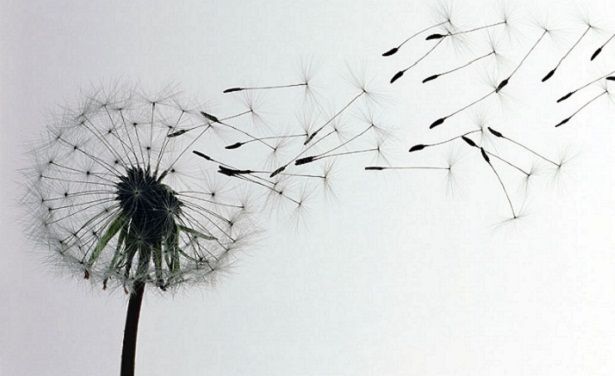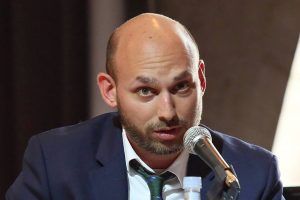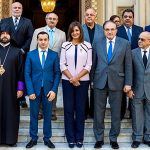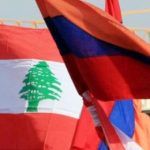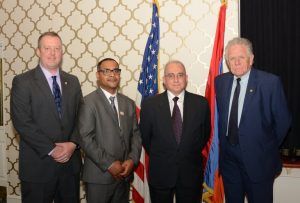Participant of the 2016 “Diaspora” Summer School Program: “Unity must be our driving force”

The foundations for Armenian-Finnish relations were laid back in the 17th century when the merchants of New Djulfa established trade relations with Scandinavia. Later, those relations became stronger. In the mid-20th century, Armenian intellectuals Alexander Abelyan, Garegin Levonyan, Levon Bashalyan, Stepan Shahumyan, Vahan Teryan and Vahram Papazyan (Papazyan performed “Othello” four times with Finnish actors in Helsinki) visited Finland, but few people know that there is also an Armenian community in Finland that still has many perspectives. Marina Danoyan has traveled from this beautiful country of Northern Europe to Armenia in order to participate in the Training Course for Teachers of Armenian Language and History and Organizers of Education, which is part of the “Diaspora” Summer School Progam of the RA Ministry of Diaspora. Hayern Aysor’s correspondent talked about the Armenian community of Finland, the small Armenian school and the perspectives in an interview with the Armenian teacher.
Hayern Aysor: Marina, there is not much said about the Armenian community of Finland. What is the state of the community today? What is it involved in?
Marina Danoyan: The Finns and the Armenians have had relations throughout history, but the organized Armenian community of Finland hasn’t been around for a long time. It is a small community, but there are Armenians based in Helsinki, as well as in Tampere and Turku. There are about 2,000 Armenians. Although the community is small, we already have two Armenian centers, including the Finland-Armenia Association, which has assumed the task of holding cultural, educational and disciplinary events, and the representation of the Armenian Apostolic Church, which is more spiritually-oriented.
However, the main goal of the two centers is to consolidate Armenians and create an atmosphere of unity. Of course, Armenians abroad are always at risk of assimilating, but most of the members of our community, at least whom I know, have settled in Finland in the past decades and are mainly from Armenia. Over the past few years, our community grew larger in number when the Armenians of the Near East, especially the Armenians of Syria moved to European countries, including Finland following the armed operations that began in the Near East. Of course, the Armenians of the Near East are quite conservative in terms of the Armenian identity and have mainly settled in Turku where the representation of the Armenian Apostolic Church is trying to create an Armenian environment for them and fill the gap of “Armenianness”. Father Yeghishe from Stockholm also visits Helinski very often. He meets with the Armenians and serves Holy Masses.
Hayern Aysor: However, I assume that the community also has problems and difficulties.
M. D.: There are obviously problems since the Armenian community is becoming more and more organized and trying to make new achievements every day, and the path that we have chosen and every road that leads to success is not smooth at all. The main goal is to maintain the Armenian environment. We talked about assimilation. I must note and record that the active members of the Armenian community are very goal-oriented individuals and want to preserve their Armenian identity. Thus, they want to feel Armenian and feel that they belong to the nation.
However, I must also state that only some of the members of the community are active members, and this is a problem. The Armenians of our community are very different from each other. They are different in terms of integration into the community, professions, jobs and views, but there is one thing that brings us all together-we are Armenian. Unity must be our driving force. I know everything is just beginning, but I also know that our community has great potential and great human resources. If each member tries to make his small contribution to the development and empowerment of the community, we will overcome any obstacle on the road to success.
Hayern Aysor: Do the Finns talk about the Armenians? Do they know the Armenians, or has the distance between Finland and Armenia stopped the flow of information?
M. D.: The Finns don’t know much about Armenia. Even if they do, they only know about Armenia in the context of the Armenian Genocide. However, when I talk about Armenia, they show great interest. Our centuries-old history and the fact that the Armenians were the first nation to adopt Christianity as a state religion motivate them. This leads them to Armenia to discover the country. The Orthodox Church of Helsinki has a representative, Monk Serafim, who is a fan of Armenia and Armenian history and has written books devoted to Armenia and the Armenian Apostolic Church. He has gathered other Finns who have become fans of Armenia after examining the country and Armenian history. They visit Armenia, and those who visit Armenia at least once, become connected to our country forever. They are also involved in our community’s activities and want to make their contributions.
Hayern Aysor: How was the small one-day Armenian school established? What has it done over the past year?
M. D.: The school was established by the Finland-Armenia Association, and I am the vice-president of that association. In the classic sense, we can’t call it a school because it is a one-day school with few class hour, but in terms of its mission, it is truly a school that provides education and carries out activities aimed at preserving the Armenian identity. As you mentioned, the school was founded a year ago. The main and primary goal is to teach Armenian. Armenian children mainly speak Armenian at home, but they can’t read and write in Armenian. We gathered a group of 15 children. I was offered to be their teacher, and I accepted the offer with great pleasure. When I saw how motivated the children were and how willing they were to learn Armenian, I also became motivated. There is a lot to learn, yet few class hours. We have big plans, and we have to continue with persistence. The parents are also very motivated. We held a year-end ceremony at the end of the school year. For the first time, the children sang, presented what they had learned over the past year and even put on a play. We achieved some results over the past year. The group comprises children between the ages of 5 and 12. It is hard to teach everyone with the same method, especially since they have different levels of Armenian language proficiency. There is also a lack of resources, but these are problems that will be solved sooner or later. The most important thing is that the children are communicating in Armenian with pleasure and attending the lessons with joy.
Hayern Aysor: Marina, do you raise your children with the same spirit?
M. D.: Yes, of course! My daughter is 4-and-a-half years old and always participates in the Armenian language lessons. She likes the lessons, and we talk about Armenia together. One day, I told my students about the Armenian national flag. We drew the flag and I explained the meaning of each of the colors. My daughter was very impressed. She would constantly draw the flag at home and sort accessories in a way to reflect the Armenian tricolor flag. She would speak in Finnish until she was 2-and-a-half years old, and then she suddenly started speaking in Armenian. It is more comfortable and interesting for her since any non-Armenian won’t understand her. Her Armenian identity is forming little by little, and this inspires me. My husband, whose father is Armenian and mother is Finnish, also wants our children to grow up in an Armenian environment. We do everything we can to preserve the Armenian identity. When they grow up, they can choose how to stay connected to their homeland.
Hayern Aysor: Now let’s touch upon the “Diaspora” Summer School Program. What do you get out of it as a beginner?
M. D.: You are right. I don’t have much teaching experience. I had a lot of questions right from the first day of the training course. How can I start teaching Armenian? Which method is more effective? I have read methodological books, but I have always needed professional advice. One day, I met with Ambassador Extraordinary and Plenipotentiary of Armenia to Sweden and Finland Artak Apitonyan and learned about this summer school program. I immediately wanted to participate and thought it would be helpful, and I wasn’t wrong. The best professionals provide us with useful knowledge, methods and examples every day and are always read to answer our questions. Of course, another feature of this summer school program is that it provides us with a unique opportunity to meet with Armenian teachers of schools of different Armenian communities, most of whom have many years of teaching experience. We have conversations during very break or on our free time. When the other teachers learn that I am a beginner, they express willingness to help me and provide materials. I am certain that we will maintain ties.
Hayern Aysor: What is your advice to all Diaspora Armenian teachers for whom teaching has become a real calling?
M. D.: You know, the family, the environment and the teacher are the first to play a role in the formation of a child. A lot depends on a Diaspora Armenian teacher. Can a Diaspora Armenian teacher be able to attract the child in such a way to make him learn Armenian with pleasure? If an Armenian child learns Armenian with interest, he will also be interested in the homeland. In this case, being a teacher is truly a calling. First and foremost, it is a calling that is binding. I always prepare before a lesson, feel obliged to do my best and feel the burden on my shoulder.
Amalya Karapetyan




 Արևելահայերեն
Արևելահայերեն Արևմտահայերեն
Արևմտահայերեն Русский
Русский